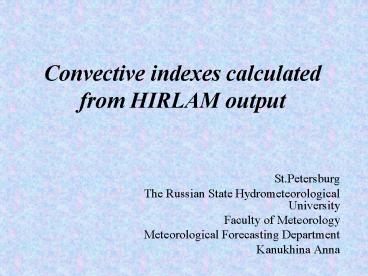Convective indexes calculated from HIRLAM output PowerPoint PPT Presentation
Title: Convective indexes calculated from HIRLAM output
1
Convective indexes calculated from HIRLAM output
- St.Petersburg
- The Russian State Hydrometeorological University
- Faculty of Meteorology
- Meteorological Forecasting Department
- Kanukhina Anna
2
Aims
- to estimate possible use of convective indexes
calculated on HIRLAM outputs for forecasting of
place, beginning time and type of mesoscale
convective phenomena
3
Initial data are HIRLAM analysis and forecast
files
- - air temperature at surface and heights at
various periods - - dew point temperature at surface and heights at
various periods - - wind parameters at surface and heights at
various periods - - surface pressure tendencies
- - specific humidity at surface and heights at
various periods
4
3 types of indexes
- diagnostic - atmospheric preparedness for
convection development (?, ?, MOCON) - index having triggering function (? )
- indexes estimating possible type of arising
phenomena (CAPE,HEI)
5
atmosphere statical stability index ?
- ??
- ?
6
moisture convergence
- MOCON
- r specific humidity, kg/kg
- V wind speed at 10 m, m/s
7
generalized index indicating possibility of
convective disturbance formation ?
- ?
8
convective instability indicator (Falkovichs
index) ?
- ?
9
EHI energy helicity index
- EHI CAPEH
- ? relative wind helicity
- CAPE convective available potential energy
- CAP?
10
Studied cases divided into 3 groups
- 1 group days with thunderstorms and showers
indexes indicate high possibility of these
weather phenomena - 2 group days without any convective phenomena
but indexes shows existing possibility of
phenomena arising( atmospheric instability) - 3 group days associated with thunderstorms and
showers atmosphere is stable according to
indexes consideration
11
Used data
- HIRLAM forecast
- HIRLAM analysis
- sounding data
- surface observations (synoptic charts OSCAR,
registered thunderstorm charts from FMI site
http//www.ava.fmi.fi/tjt/salark.html).
12
Studied cases
- 29.06.200019.06.200121-23.11.200103-06.07.20
0216-20.07.2003
13
23.11.2001 12UTC
14
Indexes profiles for Kardla, Estonia
15
MOCON, 1/s for Kardla (Estonia) on 23.11.2001 12
UTCanalyse fc12
fc24
16
MOCON and ? scattering graph for 6 h forecast
(on base of analisys on 23.11.2001 0600 UTC and
forecast 23.11.2001 0000 UTC)
17
? and G scattering graph for 6 h forecast (on
base of analisys on 23.11.2001 0600 UTC and
forecast 23.11.2001 0000 UTC)
18
CAPE and HEI scattering graph for 6 h forecast
(on base of analisys on 23.11.2001 0600 UTC and
forecast 23.11.2001 0000 UTC)
19
29.06.2000 12UTC
20
MOCON, CAPE analysis on 29.06.2000 12 UTC
21
- Thunderstorms chat on 29.06.2000
- (http//www.ava.fmi.fi/tjt/salark.html)
22
(No Transcript)
23
(No Transcript)
24
?APE and MOCON scattering graph for 24 h forecast
(on base of analisys on 29.06.2000 1200 UTC and
forecast 28.06.2000 1200 )
25
? and G scattering graph for 24 h forecast (on
base of analisys on 29.06.2000 1200 UTC and
forecast 28.06.2000 1200 )
26
Indexes correlation coefficients (forecast and
analysis)
- ??? 1 ?
- ??? 2 G
- ??? 3 ?
- ??? 4 ?APE
- ??? 5 MOCON
- ??? 6 HEI
27
Conclusions
- ? values defined by forecasts have essential
distinctions with calculations from analysis and
? can not be used for atmospheric state
estimation when forecasting at period more than
6h. - The same could be said for HEI.
- CAPE and MOCON may be used forecasting at period
no more than 12h. - ? and G forecasts are close to real situation
even at 24h forecast period particularly for C
values.

